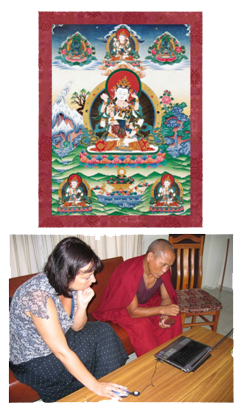Mental Imagery and Human-Computer Interaction Lab
Meditation
 Kozhevnikov, Louchakova, Josipovic, & Motes (2009) examined the effects of meditation on mental imagery, evaluating Buddhist monks’ reports concerning their extraordinary imagery skills. Practitioners of Buddhist meditation were divided into two groups according to their preferred meditation style: Deity Yoga (focused attention on an internal visual image) or Open Presence (evenly distributed attention, not directed to any particular object). Both groups of meditators completed computerized mental-imagery tasks before and after meditation. Their performance was compared with that of control groups, who either rested or performed other visuospatial tasks between testing sessions. The results indicate that all the groups performed at the same baseline level, but after meditation, Deity Yoga practitioners demonstrated a dramatic increase in performance on imagery tasks compared with the other groups. The results suggest that Deity meditation specifically trains one’s capacity to access heightened visuospatial processing resources, rather than generally improving visuospatial imagery abilities.
Kozhevnikov, Louchakova, Josipovic, & Motes (2009) examined the effects of meditation on mental imagery, evaluating Buddhist monks’ reports concerning their extraordinary imagery skills. Practitioners of Buddhist meditation were divided into two groups according to their preferred meditation style: Deity Yoga (focused attention on an internal visual image) or Open Presence (evenly distributed attention, not directed to any particular object). Both groups of meditators completed computerized mental-imagery tasks before and after meditation. Their performance was compared with that of control groups, who either rested or performed other visuospatial tasks between testing sessions. The results indicate that all the groups performed at the same baseline level, but after meditation, Deity Yoga practitioners demonstrated a dramatic increase in performance on imagery tasks compared with the other groups. The results suggest that Deity meditation specifically trains one’s capacity to access heightened visuospatial processing resources, rather than generally improving visuospatial imagery abilities.
Maria Kozhevnikov was featured in the Association for Psychological Science press release announcing her paper: The Enhancement of Visuospatial Processing Efficiency Through Buddhist Deity Meditation.